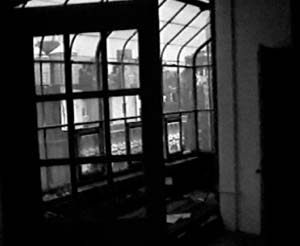The earlier film of the two, Schwebebahn, 1995, refers to a specific train in the German city of Wuppertal built in 1900. It is a unique inverted monorail, a floating train suspended on iron rails above the city, thus conveying a sense of hovering and offering an independent, alternative structure for movement through the city. Almond intertwines the experience of the traveler on the train and the sights unfolding before him with the experience of the observer standing away from the train, following its motion, against the backdrop of the city and the rail’s steel skeleton. Manipulating the straightforward appearance of documentation, he presents the film in reverse, inverting the frame so that sky becomes earth and the suspended train appears as though it is traveling on conventional tracks. Incorporating grainy coloration, black-and-white segments and monotonous techno music, he creates an intriguing link between old technology and a dark futuristic look. Through these modifications and manipulations Almond explores the viewer’s ability to perceive the reality revealed to him, as in his series of nocturnal photographs shot during full moon using long exposures (Night as Day).
In his projects dedicated to trains, such as a subterranean train in a Russian coal mine or the ghost train in a Vienna fairground (Geisterbahn, 1999), Almond emphasizes the recurrent movement that generates a closed structure. Such structure underlies the second work included in the current show – The Guest, 1998. It features a photograph of movement in a repetitive cyclical route inside a high-rise apartment building, with a view of the metropolis teeming with skyscrapers seen through its window. The incessant movement, the entry to and exit from the various rooms, the strenuous stair climbing – all these stand in stark contrast to our own passivity as viewers. They conjure up the experience of a ghost train rider who undergoes a manipulative experience of movement in a physical track, while sitting passive and motionless in a carriage. The heavy breathing of the person running restlessly around the house reinforces the harsh monotony of movement, generating tension and disconcertment in the viewer. In an interview with Louisa Buck for The Art Newspaper (no. 01, March 2000) Almond affirms that his train-related works shot outside England are more experimental and less biographical, delving into basic questions of time, space and movement, while the cultural element is latent and concealed more deeply.
Less Reading...
